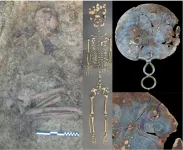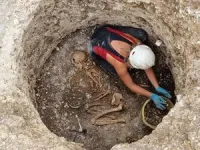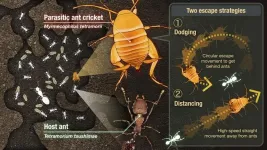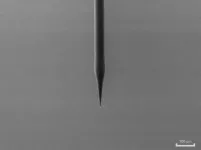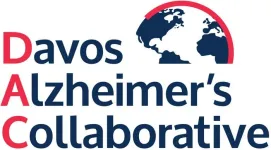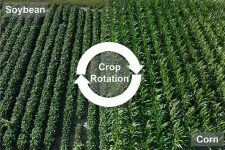(Press-News.org)
An international team of geneticists, led by those from Trinity College Dublin, has joined forces with archaeologists from Bournemouth University to decipher the structure of British Iron Age society, finding evidence of female political and social empowerment.
The researchers seized upon a rare opportunity to sequence DNA from many members of a single community. They retrieved over 50 ancient genomes from a set of burial grounds in Dorset, southern England, in use before and after the Roman Conquest of AD 43. The results revealed that this community was centred around bonds of female-line descent.
Dr Lara Cassidy, Assistant Professor in Trinity’s Department of Genetics, led the study that has been published in leading international journal Nature today. She said: “This was the cemetery of a large kin group. We reconstructed a family tree with many different branches and found most members traced their maternal lineage back to a single woman, who would have lived centuries before. In contrast, relationships through the father’s line were almost absent.
“This tells us that husbands moved to join their wives’ communities upon marriage, with land potentially passed down through the female line. This is the first time this type of system has been documented in European prehistory and it predicts female social and political empowerment.
“It’s relatively rare in modern societies, but this might not always have been the case.”
Incredibly, the team found that this type of social organisation, termed “matrilocality”, was not just restricted to Dorset. They sifted through data from prior genetic surveys of Iron Age Britain and, although sample numbers from other cemeteries were smaller, they saw the same pattern emerge again and again.
Dan Bradley, Professor of Population Genetics in Trinity’s Department of Genetics, and a co-author of the study, added: “Across Britain we saw cemeteries where most individuals were maternally descended from a small set of female ancestors. In Yorkshire, for example, one dominant matriline had been established before 400 BC. To our surprise, this was a widespread phenomenon with deep roots on the island.”
Iron Age cemeteries with well-preserved burials are rare in Britain. Dorset is an exception, due to the unique burial customs of the people who lived there, named as the “Durotriges” by the Romans. The researchers sampled DNA from a site near the village of Winterborne Kingston, nicknamed “Duropolis”, which archaeologists from Bournemouth University have been excavating since 2009. Previously, the team had observed the more richly furnished Durotrigan burials to be those of women.
Dr Miles Russell, the excavation’s director and co-author on the study, commented: “Beyond archaeology, knowledge of Iron Age Britain has come primarily from the Greek and Roman writers, but they are not always considered the most trustworthy. That said, their commentary on British women is remarkable in light of these findings. When the Romans arrived, they were astonished to find women occupying positions of power. Two of the earliest recorded rulers were queens – Boudica and Cartimandua – who commanded armies.
“It’s been suggested that the Romans exaggerated the liberties of British women to paint a picture of an untamed society. But archaeology, and now genetics, implies women were influential in many spheres of Iron Age life. Indeed, it is possible that maternal ancestry was the primary shaper of group identities.”
Anthropologist Dr Martin Smith, one of the project’s bone specialists, added: “These results give us a whole new way of looking at the burials we are uncovering with our students. Rather than simply seeing a set of skeletons, hidden aspects of these people’s lives and identities come into view as mothers, husbands, daughters and so on. We also see these folk had deep knowledge of their own ancestry – multiple marriages between distant branches of this family occurred and were possibly favoured, but close inbreeding was avoided.”
Echoing the writings of Julius Caesar, the researchers further uncovered a footprint of Iron Age migration into coastal southern England, which had gone undetected in prior genetic studies. This will add more fuel to debates surrounding the arrival of Celtic language in Britain.
Dr Cassidy explained: “Migration into Britain during the later Bronze Age has previously been detected, leading some to hypothesise that Celtic language arrived during this period. But our results point towards substantial cross-channel mobility during the Iron Age as well. Narrowing down the arrival time of Celtic will be difficult. Indeed, it is quite possible that Celtic languages were introduced to Britain on more than one occasion.”
END
Researchers at Nagoya University in Japan have discovered sophisticated behavioral strategies that enable parasitic crickets to survive within ant colonies. Led by Ryoya Tanaka, the team documented how these insects successfully navigate life among potentially lethal hosts through precise evasion tactics. Their findings, published in Communications Biology, reveal remarkable adaptations that allow these cricket species to thrive in a hostile environment.
Animals that live in ant colonies, known as “ant guests”, exploit their hosts’ resources. However, this ...
WASHINGTON — Researchers have developed a reliable and reproducible way to fabricate tapered polymer optical fibers that can be used to deliver light to the brain. These fibers could be used in animal studies to help scientists better understand treatments and interventions for various neurological conditions.
The tapered fibers are optimized for neuroscience research techniques, such as optogenetic experiments and fiber photometry, which rely on the interaction between genetically modified neurons and visible light delivered to and/or collected from the brain.
“Unlike standard optical fibers, which are cylindrical, the tapered fibers we developed have a conical shape, which ...
HOUSTON, January 15, 2025 — The American Heart Association has named Syracuse University’s Fran Brown as the recipient of the 2024 Paul “Bear” Bryant Newcomer Coach of the Year Award. This award celebrates the achievements of an individual who has not had any previous head coaching experience at the NCAA Division I football sub-division (FBS) level.
Coach Brown will be recognized with the honor during the 2025 Bear Bryant Awards on January 22.
After being named Syracuse’s 31st head coach on November 28, 2023, Brown immediately instilled a culture of ...
By Benjamin Boettner
(BOSTON) — Currently, no anesthetic compound or cocktail can be used safely outside of a hospital facility. This is because current drugs impair the brain and central nervous system’s ability to regulate a number of vital processes, including respiration, body temperature, and heart rate in addition to creating a state of unconsciousness or sedation, making the strict monitoring of patients with the help of sophisticated instruments and highly-trained clinical personnel an absolute necessity. To reduce trauma associated with injuries and improve combat casualty outcomes, under a new DARPA-ABC contract ...
The Offshore Wind Innovation Hub today announced the opening of its 2025 application process, designed to identify and support entrepreneurial and innovative companies that will help unleash the potential of the dynamic emerging offshore wind industry.
Winners take on a six-month mentoring and business development program residency designed to prepare them for strategic partnerships with major offshore wind developers and to be part of the larger offshore wind value chain. The program aims to enable innovators to overcome barriers ...
The Aligning Science Across Parkinson’s (ASAP) initiative opened applications for members of the research community to apply to join the Collaborative Research Network (CRN) 2025 Scientific Track. The new Scientific Track grants will support collaborative research teams focused on dissecting the mechanisms that contribute to Parkinson’s disease (PD) heterogeneity across one of six focus areas listed below, offering funding of up to $3 million per year over three years.
Examining PD in the context of aging
Understanding how co-pathologies can influence PD pathogenesis and progression
Dissecting ...
Three scientists were awarded the 2024 Kaul Foundation Prize for Excellence in Plasma Physics Research and Technology Development based on their decades of groundbreaking research about how plasma behaves in fusion reactors.
Choongseok (CS) Chang, Seung-Hoe Ku and Robert Hager of the U.S. Department of Energy’s (DOE) Princeton Plasma Physics Laboratory (PPPL) were recognized “for experimentally validated simulations of turbulence-broadened divertor heat flux widths using the X-Point Included Gyrokinetic Code (XGC),” following decades of research developing comprehensive simulations to model the fusion plasma edge.
Recently, ...
The Davos Alzheimer’s Collaborative (DAC), a pioneering worldwide initiative seeking to cure Alzheimer’s disease and improve brain health, today announced the launch of its Brain Health Navigator program. The initiative led by the DAC Healthcare System Preparedness (DAC-SP) team will provide resources for patients and providers at six sites across the U.S.
Despite Alzheimer’s status as a growing worldwide epidemic, pathways for accurate diagnosis and evidence based interventions including new therapies are either underdeveloped or non-existent. ...
New York, NY – Jan. 15, 2025 –We are excited to welcome you to San Francisco for the ATS 2025 International Conference! Journalists will have access to leaders, as well as emerging scientists and clinicians, who are at the forefront of medical breakthroughs and clinical innovation in pulmonary, critical care and sleep medicine.
Join us beginning Sunday, May 18* through Wednesday, May 21. Register now and check out our Program at a Glance.
As always, you are welcome to contact the ATS communications and marketing director about scientific sessions and expert interviews whether you are joining us in person or from your (home) office. Registered ...
MINNEAPOLIS / ST. PAUL (01/15/2024) — A study by researchers at the University of Minnesota Twin Cities offers new insights into how alternating corn and soybean crops can help increase crop yield in a changing climate.
The research is published in the peer-reviewed scientific journal Global Change Biology.
Rising temperatures and weather extremes are threatening global food security, making it crucial to understand how sustainable practices like crop rotation can help improve agricultural yields and resilience.
The study found that the benefits to corn-soybean rotation, compared to continuous corn year after year, are extremely sensitive to ...
